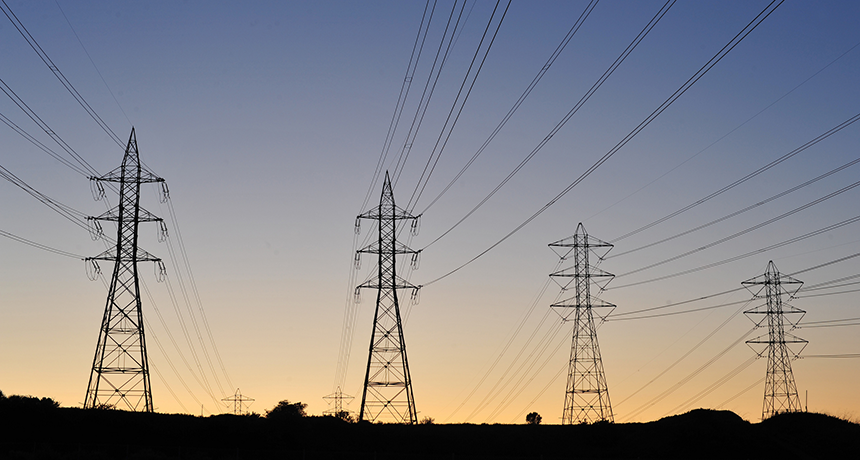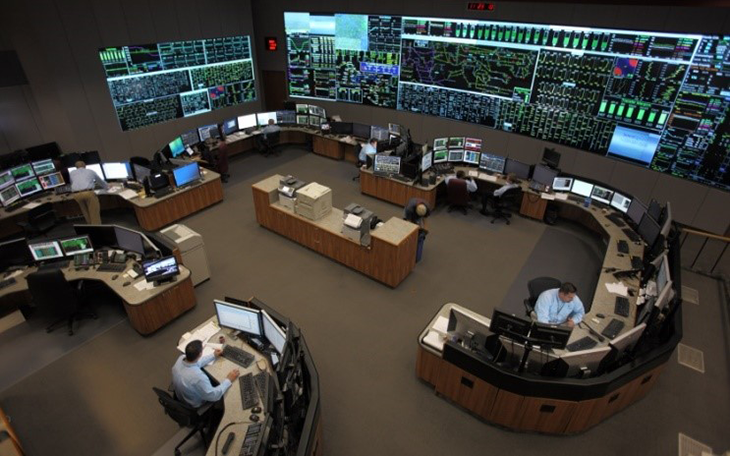Explainer: What is the electric grid?
Round-the-clock work keeps the giant network going so the lights stay on

High-voltage electric lines are part of the giant network that makes up the electric grid.
Chris Hunkeler/Flickr (CC BY-SA 2.0)
Flip a switch at home, and a light or gadget comes on. In most cases, the electricity to power that device came from a huge system called the electric grid. Here’s how it works.
Maybe you’ve built an electric circuit with a battery and a light bulb. Current flows from the battery through wire to the light bulb. From there it flows through more wire and back to the battery. You also can set up the wires to connect multiple light bulbs so some can be on even if others are off. The electric grid uses a similar idea, but it’s more complex. A lot more.
Electricity gets made at lots of places: Power plants that burn oil, gas or coal. Nuclear plants. Solar panel arrays. Wind farms. Dams or falls over which water cascades. And more. In most places, the grid connects hundreds or more of these places to a vast network of wires and equipment. Electric current can travel along many paths within the network. Power also can flow either way along wires. Equipment tells the current where to go.
Two-way wires also allow the use of alternating current, or AC. Electric grids in most countries use AC current. AC means the current switches direction many times per second. With AC, equipment called transformers can change the voltage, or force of the current. High voltage is more efficient for sending electricity over long distances through wires. Other transformers then step the voltage down to lower, safer levels before the current travels on to homes and businesses.
A balancing act
The electric grid is so big and complex that it needs whole buildings full of people and machines to control it. Those groups are called grid operators.
A grid operator is a bit like a high-tech traffic cop. It makes sure power goes from electricity producers (known as generators) to where people will need it. The United States’ lower 48 states have 66 of these traffic cops. They work in three major regions. The largest span parts of more than a dozen states! Local electric companies do a similar job in their areas.
There’s a catch. “We need to keep things perfectly balanced,” explains electrical engineer Chris Pilong. He works at PJM Interconnection in Audubon, Penn. PJM runs the grid for all or parts of 13 states, plus the District of Columbia.

By balanced, Pilong means that the amount of electricity supplied at any time must match the amount used. Too much power could overheat wires or damage equipment. Too little power can lead to problems such as blackouts and brownouts. Blackouts are losses of all power to some region. Brownouts are partial drops in the system’s ability to supply power.
Computers help engineers get the match right.
Meters, gauges and sensors constantly monitor how much electricity people are using. Computer programs also use data about electricity use during periods in the past when the hour, day and weather were similar. All that information helps the grid’s traffic cops figure out how much electricity needs to go on the grid to meet people’s needs. Grid operators make those forecasts from minute to minute, hour to hour and day to day. Grid operators then tell producers how much more power — or less — to supply. Some big customers also agree to cut back their energy use when needed.
The system isn’t perfect and things do go wrong. Indeed, grid operators expect problems will develop now and again. “It’s a normal occurrence,” says Ken Seiler, who heads up system planning at PJM. “But it’s more the exception than the rule.” If one power plant suddenly stops putting its power onto the grid, others are usually on standby. They’re ready to supply electricity as soon as the grid operator gives the go-ahead.
Most power outages actually take place at the local level. Squirrels chew through wires. A storm brings down power lines. Equipment somewhere overheats and catches on fire. But extra trouble can pop up when extreme weather or other emergencies happen.
Hurricanes, floods, tornadoes and other events can all bring down parts of the system. Droughts and heat waves can spike the use of air conditioners — big energy hogs! Different kinds of extreme weather will become more frequent as climate change intensifies.
The risk of physical or cyber-attacks presents additional threats. Even space weather can make problems flare up on the grid. Beyond all this, many parts of the power-grid system are more than 50 years old. They can just break down.
Looking ahead
Scientists and engineers are working to prevent problems. But when problems do occur, they want to get the lights back on as soon as possible.
Engineers also are working to adapt the grid to a changing electricity supply. Natural-gas prices have fallen because of a recent boom in gas production in the United States and other countries. As a result, older coal and nuclear plants have trouble competing with the low-cost power generated in plants that run on natural gas. Meanwhile, more wind power, solar energy and other renewable resources are joining the mix. Prices for these clean-energy alternatives have fallen a lot in recent years.
Battery storage also will let renewable energy play a bigger role. Batteries can store extra electricity from solar panels or wind farms. Then the energy can be used regardless of the time of day or the weather at the moment.
At the same time, the grid will rely even more on computers so that many systems can “talk” to each other. More advanced equipment will go onto the system too. Some “smart switches” will get the lights back on more quickly when there’s a problem. Others can more nimbly steer electricity onto the grid from renewable energy sources. Meanwhile, sensors and other devices will pinpoint problems, boost efficiency and more.
Many customers want more data as well. Some want to see their energy use detailed in 15-minute chunks. That can help them focus their energy-saving efforts. Many people also want to pay more or less based on the time of day that they actually use electricity.
“Smart grid” initiatives aim to deal with all those issues. Research continues at universities and other research centers. Ideally, all of this work can make the grid more reliable and resilient.







